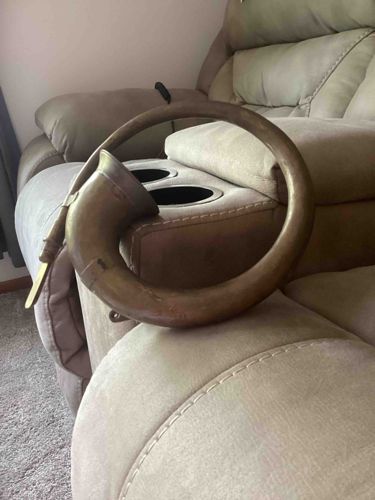
Vintage Hunting Horn / Post Horn
The item appears to be a vintage hunting horn, also known as a post horn or coach horn, characterized by its distinctive circular, coiled shape. It is constructed from a metal, likely brass or bronze, given its tarnished, dulled golden-brown hue, indicating a significant patina that has developed over time. The primary section is a continuously curved tube forming a large circle, with one end flaring out into a bell and the other narrowing to accept a mouthpiece (which is not visible in the image). The bell section shows some signs of gentle flaring and shaping. Visible condition issues include significant tarnishing and discoloration across the entire surface, consistent with aged metal that has not been recently polished. There may be minor dents or surface abrasions, though they are not clearly discernible from the provided image quality. The overall construction appears robust, suggesting good craftsmanship despite its age and visible wear. A small, flat, rectangular piece of a lighter-colored metal, possibly silver-plated brass or nickel, is attached near the bell, acting as a decorative or reinforcing element, though its exact purpose or marking cannot be determined. The absence of valves or keys confirms its identity as a natural horn, relying solely on the player's embouchure and breath for pitch variation. Based on its design and material characteristics, it likely dates from the late 19th to early 20th century, a period when such horns were popular for communication signals or ceremonial purposes. Its rustic appearance and visible age suggest it has been well-used or stored for an extended period, contributing to its current aesthetic.
AI-Generated Appraisal Disclaimer
Estimated Value
$400-600
Basic Information
Category
Musical Instrument
Appraised On
December 7, 2025
Estimated Value
$400-600
Item Description
The item appears to be a vintage hunting horn, also known as a post horn or coach horn, characterized by its distinctive circular, coiled shape. It is constructed from a metal, likely brass or bronze, given its tarnished, dulled golden-brown hue, indicating a significant patina that has developed over time. The primary section is a continuously curved tube forming a large circle, with one end flaring out into a bell and the other narrowing to accept a mouthpiece (which is not visible in the image). The bell section shows some signs of gentle flaring and shaping. Visible condition issues include significant tarnishing and discoloration across the entire surface, consistent with aged metal that has not been recently polished. There may be minor dents or surface abrasions, though they are not clearly discernible from the provided image quality. The overall construction appears robust, suggesting good craftsmanship despite its age and visible wear. A small, flat, rectangular piece of a lighter-colored metal, possibly silver-plated brass or nickel, is attached near the bell, acting as a decorative or reinforcing element, though its exact purpose or marking cannot be determined. The absence of valves or keys confirms its identity as a natural horn, relying solely on the player's embouchure and breath for pitch variation. Based on its design and material characteristics, it likely dates from the late 19th to early 20th century, a period when such horns were popular for communication signals or ceremonial purposes. Its rustic appearance and visible age suggest it has been well-used or stored for an extended period, contributing to its current aesthetic.
Related Tags
Get Your Items Appraised
Instant estimates of your treasures with AI-powered instant appraisals